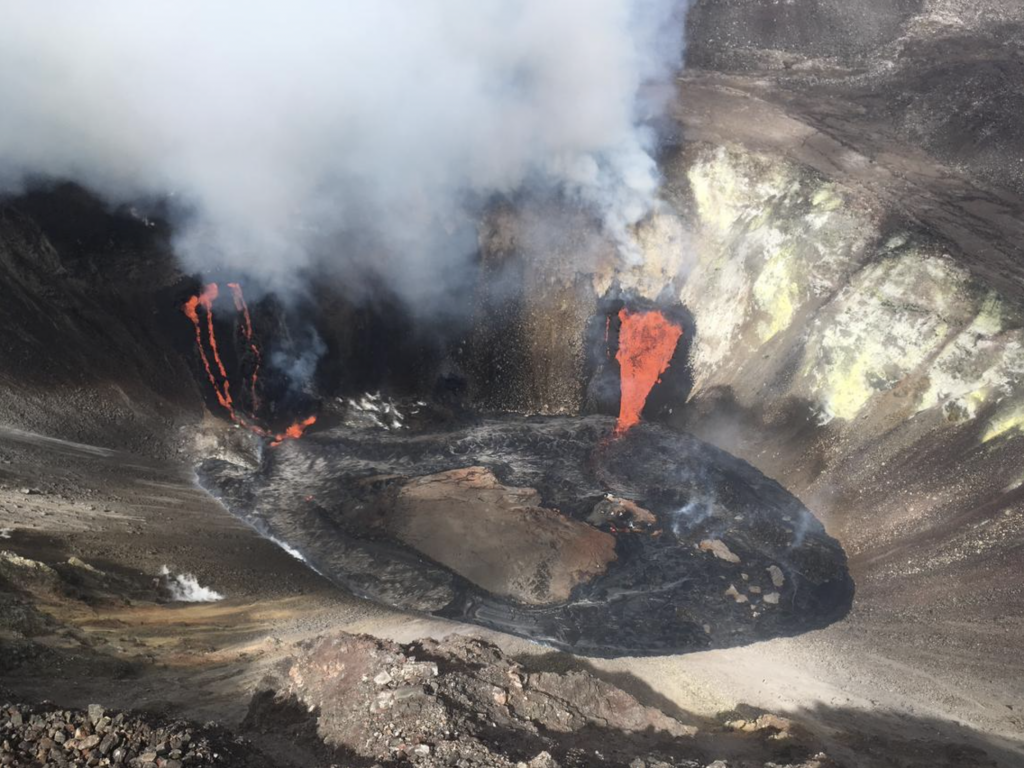Kīlauea Eruption Poses Air Quality Hazard With Increased Vog and SO2 Levels

The state Department of Health is advising the public of potential hazardous, poor air quality, due to the ongoing volcanic eruption at Kīlauea that began on Sunday, Dec. 20, 2020.
The eruptive activity is currently within the Hawaiʻi Volcanoes National Park at the summit area of Kīlauea’s Halema‘uma‘u crater.
Health officials say vog conditions and sulfur dioxide (SO₂) air levels may increase and fluctuate in various areas of the state.
The department advises that areas downwind of the summit such as Pahala and Ocean View have experienced increased levels of SO₂ that may cause problems with respiratory health, especially in sensitive individuals.

Hawai‘i residents and visitors are advised to be prepared and aware of the surrounding conditions, and how they feel or may react to vog in the air. In the event of voggy conditions, the following precautionary measures are advised:
- Reduce outdoor activities that cause heavy breathing. Avoiding outdoor activity and exercise during vog conditions can reduce exposure and minimize health risks. This is especially important for sensitive groups such as children, the elderly, and individuals with pre-existing respiratory conditions including asthma, bronchitis, emphysema, and chronic lung and heart disease.
- Stay indoors and close windows and doors. If an air conditioner is used, set it to recirculate.
- If you need to move out of an impacted area, turn on the car’s air conditioner and set it to recirculate.
- Always keep medications on hand and readily available.
- Daily prescribed medications should be taken on schedule and may provide protection from the effects of sulfur dioxide.
- Remember that face coverings and masks used to prevent the spread of COVID-19 do not provide protection from SO₂ or vog.
- Contact a doctor as soon as possible if any health problems develop.
- Do not smoke and avoid second-hand smoke.
- Drink plenty of fluids to avoid dehydration.
- Have family emergency plans prepared and ready.
- Heed warnings by county and state emergency management officials.

Visitors to the Hawaiʻi Volcanoes National Park should note that rockfalls and explosions can produce ash composed of volcanic glass and rock fragments. These ashfalls currently represent a minor hazard, but dustings of ash at areas around the Kīlauea summit are possible.
The Hawai‘i Department of Health (DOH) is encouraging residents and visitors to utilize the following resources that provide complete, clear and current information on the health effects of vog, how to protect yourself, vog and wind forecasts, air quality, changing conditions, and advice for visitors:
- Hawaiʻi Interagency Vog Information Dashboard at www.ivhhn.org/vog/ for the most comprehensive and up-to-date online information on vog and SO₂ from volcanic activity.
- DOH’s Clean Air Branch maintains a near-real time network of air quality monitors that detect SO₂ and particulate matter: https://health.hawaii.gov/cab/hawaii-ambient-air-quality-data/
- United States Geological Society (USGS) Kīlauea Volcano Updates: https://www.usgs.gov/volcanoes/kilauea/volcano-updates
- National Parks Service information on safely visiting Hawaiʻi Volcanoes National Park: https://www.nps.gov/havo/learn/news/20201221_nr_new-summit-eruption-kilauea.htm
DOH’s Guidance on Short-term SO₂ Advisory Levels:

Notes:
- Asthmatics and persons with chronic respiratory disease: ALWAYS have your medications available. Reducing your exertion level so that you can breathe through your nose will reduce the amount of SO2 that reaches your lungs.
- People experiencing health effects: Contact your doctor as soon as possible if any problems develop, as respiratory conditions might worsen rapidly in heavy SO2 or vog conditions.
- People have different sensitivities to SO2. Use this table to help develop appropriate measures to protect your health and avoid serious responses.










